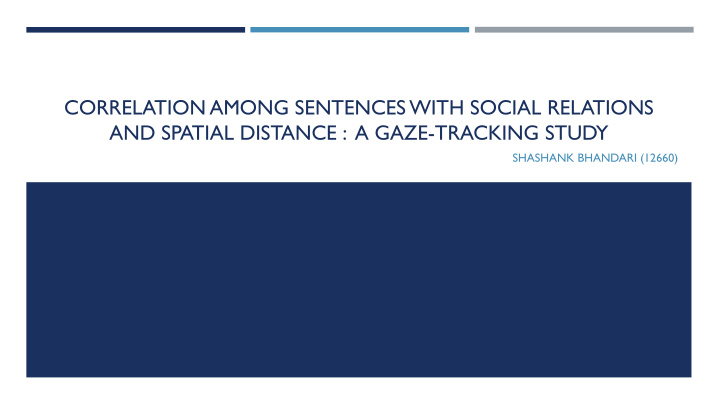



CORRELATION AMONG SENTENCES WITH SOCIAL RELATIONS AND SPATIAL DISTANCE : A GAZE-TRACKING STUDY SHASHANK BHANDARI (12660)
MOTIVATION Geurra & Knoeferle, 2014 : Spatial distance modulates reading times for sentences about social relations: evidence from eye tracking
EVERYDAY SENTENCES “She’s a close friend.”
EVERYDAY SENTENCES “She’s a close friend.”
PREVIOUS WORK Lakoff & Johnson, 1999 : “…The Conceptual Metaphor Theory suggests that such expressions arise because abstract representations such as social intimacy are grounded in physical experience such as spatial distance through metaphorical mapping…” Williams and Bargh, 2008 - Strength of bond with families vis-à-vis distance marked off on Cartesian plane Matthews and Matlock, 2011 - In a path-drawing task participants drew paths closer to figures described to them as friends Guerra & Knoeferle, 2012 : “ …Reading times were shorter for sentences expressing similarity between two abstract and-coordinated nouns when the cards were presented close together, compared to farther apart. ..”
WHAT WE ALREADY KNOW Spatial information can modulate participants’ reports on their social bonds in a way that is coherent with the conceptual metaphor hypothesis
A QUESTION WE STILL HAVE TO ANSWER Can spatial distance be directly co-indexed with the abstract concept of similarity even when there is no one-to- one mapping between coordinated objects and coordinated nouns?
EXPERIMENT DESIGN Pre-Experiment Phase : Short Questionnaire on Languages spoken by subject
EXPERIMENT DESIGN Phase 1 : A pair of cards with two nouns that will depict spatial distance A set of English sentences with the structure NP – VP – NP – ADV – PP – NP
EXPERIMENT DESIGN Phase 2 : A pair of cards with two nouns that will depict spatial distance A set of English sentences with the structure NP – ADV – VP – NP – PP – NP
NOVELTY Studying correlations in non native languages.
REFERENCES Tanenhaus, M. K., Spivey-Knowlton, M., Eberhard, K., & Sedivy, J. (1995). Integration of visual and linguistic information during spoken language comprehension. Science, 268, 1632 – 1634. Lakoff, G. & Johnson, M. (1999). Philosophy in the flesh: The embodied mind and its challenge to western thought. New York, NY: Basic Books Matthews, J. L., & Matlock, T. (2011). Understanding the link between spatial distance and social distance. Social Psychology, 42, 185 – 192. Williams, L. E., & Bargh, J. A. (2008). Keeping one's distance : The influence of spatial distance cues on affect and evaluation. Psychological Science, 19, 302 – 308.
Recommend
More recommend